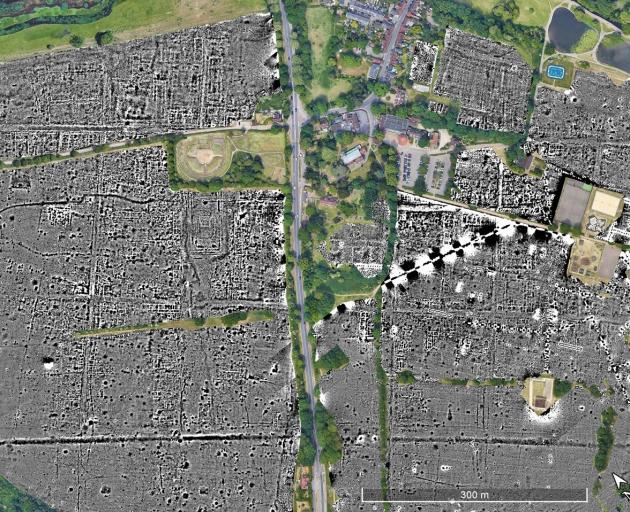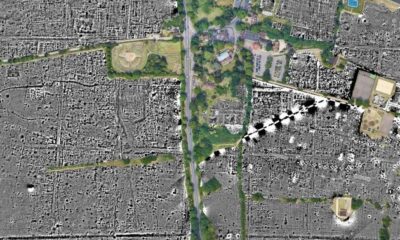Science
New Techniques Reveal Ancient Secrets of Verulamium

Recent advancements in geophysical survey techniques are shedding new light on the ancient city of Verulamium, revealing its rich historical layout. The application of a new method, the proton magnetometer, was pioneered by a team including Martin Aitken, an Oxford University scientist. This ground-breaking approach allows researchers to investigate what lies beneath the surface without extensive excavation.
Innovative Techniques Uncover Roman History
The proton magnetometer, a device resembling a bottle connected to various wires and a signal-receiving screen, enables archaeologists to detect underground disturbances. In a collaborative effort, Aitken and his team successfully mapped an early Roman defensive ditch, believed to have been hastily constructed in response to the threat posed by the formidable forces of Queen Boudicca. This discovery, initially made years ago, serves as a precursor to the current wave of archaeological exploration.
Recently, a new geophysical survey has expanded the scope of investigation across the entirety of Verulamium’s interior, which was once protected by a circuit of stone walls. The latest findings illustrate a detailed layout of the city’s streets, houses, kilns, and significant structures, such as the forum and theatre, which were situated adjacent to a large temple. This remarkable mapping provides insight into the urban planning of the Roman settlement.
Streets of History Revealed
As archaeologists delve deeper into the site, they have uncovered a grid pattern of streets dividing the city into distinct sections. Each area features elaborate houses with hypocausts, bath complexes, and intricately designed mosaic floors. The recent survey has clearly identified the early defensive ditch as a dark, straight line that makes a right angle at its western edge, further enhancing our understanding of the city’s layout.
Interestingly, the team chose not to take readings under the St Alban’s first XI cricket pitch, mindful of the groundsman’s potential disapproval. This decision highlights the delicate balance between preserving recreational spaces and uncovering historical treasures. In addition to the defensive ditch, a sinuous dark line has been identified as the aqueduct leading to the theatre, hinting at the sophisticated engineering of the time.
Previous excavations at the site yielded breathtaking discoveries, including a stunning mosaic floor featuring a lion at its center. Archaeologists believe that many more treasures lie buried beneath the surface, waiting to be unveiled. As technology continues to evolve, the potential for further discoveries at Verulamium seems limitless.
These findings not only enrich our understanding of Roman history but also emphasize the importance of innovative techniques in archaeology. The ongoing exploration of Verulamium stands as a testament to the enduring fascination with our past and the continuous quest for knowledge about ancient civilizations.
-

 World2 weeks ago
World2 weeks agoPrivate Funeral Held for Dean Field and His Three Children
-

 Top Stories2 weeks ago
Top Stories2 weeks agoFuneral Planned for Field Siblings After Tragic House Fire
-

 Sports3 months ago
Sports3 months agoNetball New Zealand Stands Down Dame Noeline Taurua for Series
-

 Entertainment3 months ago
Entertainment3 months agoTributes Pour In for Lachlan Rofe, Reality Star, Dead at 47
-

 Entertainment2 months ago
Entertainment2 months agoNew ‘Maverick’ Chaser Joins Beat the Chasers Season Finale
-

 Sports3 months ago
Sports3 months agoSilver Ferns Legend Laura Langman Criticizes Team’s Attitude
-

 Sports1 month ago
Sports1 month agoEli Katoa Rushed to Hospital After Sideline Incident During Match
-

 World3 weeks ago
World3 weeks agoInvestigation Underway in Tragic Sanson House Fire Involving Family
-

 Politics2 months ago
Politics2 months agoNetball NZ Calls for Respect Amid Dame Taurua’s Standoff
-

 Top Stories2 weeks ago
Top Stories2 weeks agoShock and Grief Follow Tragic Family Deaths in New Zealand
-

 Entertainment3 months ago
Entertainment3 months agoKhloe Kardashian Embraces Innovative Stem Cell Therapy in Mexico
-

 World4 months ago
World4 months agoPolice Arrest Multiple Individuals During Funeral for Zain Taikato-Fox





















